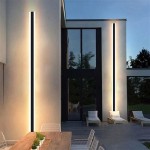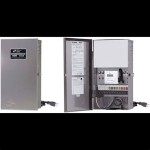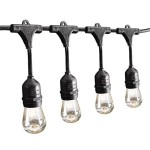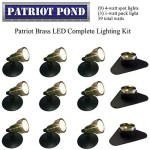Best Outdoor Landscape Lighting Kits for Illuminating Your Property
Outdoor landscape lighting significantly enhances the aesthetic appeal and functionality of a property. It not only illuminates pathways and outdoor living spaces, contributing to safety and security, but also accentuates architectural features and landscaping elements, creating a welcoming and visually pleasing environment. Selecting the right lighting kit, however, can be a complex process given the variety of options available. This article provides a comprehensive overview of key considerations when selecting the best outdoor landscape lighting kit for specific needs and preferences.
Understanding Different Types of Landscape Lighting
Landscape lighting kits typically incorporate a range of lighting fixtures, each designed for a specific purpose. Understanding these different types is crucial for creating a layered and effective lighting scheme. These categories include path lighting, spotlights, floodlights, and specialty lights.
Path Lighting: Path lights are designed to illuminate walkways, driveways, and garden paths. They typically feature a downward-facing light source to prevent glare and provide sufficient illumination for safe navigation. Path lights are often spaced several feet apart, creating a continuous line of light that guides visitors and highlights the contours of the landscape. Materials commonly used for path lights include stainless steel, aluminum, and copper, chosen for their durability and weather resistance. Considerations for path lights include the height of the fixture, the brightness of the light, and the overall style compatibility with the landscape design.
Spotlights: Spotlights are used to highlight specific features, such as trees, shrubs, or architectural details. They provide a focused beam of light that draws attention to the chosen subject. Spotlights can be used to create dramatic shadows and highlights, adding depth and dimension to the landscape. These lights often feature adjustable heads, allowing for precise aiming and positioning. The beam angle of the spotlight determines the width of the illuminated area, which is a key consideration when selecting spotlights for different objects. Wider beam angles are suitable for broader features, while narrower beam angles are ideal for focusing on specific details.
Floodlights: Floodlights provide a broad, diffused light that illuminates larger areas, such as patios, decks, or entire sections of the garden. They are often used for security purposes, providing increased visibility and deterring potential intruders. Floodlights typically have a wider beam angle than spotlights, and they are often mounted higher up to maximize their coverage area. The lumen output of floodlights should be carefully considered to ensure adequate illumination without creating excessive glare or light pollution. Shielding can be added to floodlights to direct the light downwards and minimize upward light spill.
Specialty Lights: Specialty lights encompass a variety of niche lighting options, including pond lights, deck lights, and step lights. Pond lights are designed to be submerged in water, creating a dramatic effect by illuminating underwater features and aquatic plants. Deck lights are typically low-voltage fixtures that are mounted on deck railings, posts, or stairs, providing ambient lighting and enhancing safety. Step lights are similar to deck lights and are installed on stair risers to illuminate steps and prevent tripping hazards. These specialty lights often require specific installation considerations to ensure their longevity and performance.
In addition to the different types of fixtures, the light source itself plays a critical role. Traditional incandescent bulbs have largely been replaced by energy-efficient LED alternatives. LED lights consume significantly less energy, offer a longer lifespan, and produce less heat, making them a more sustainable and cost-effective choice for landscape lighting.
Key Features to Consider in Landscape Lighting Kits
When selecting a landscape lighting kit, several key features should be considered to ensure the kit meets specific needs and provides lasting performance. These features include voltage, materials, ease of installation, and smart technology integration.
Voltage: Landscape lighting systems are typically available in two voltage options: low voltage (12V) and line voltage (120V). Low-voltage systems are generally preferred for residential applications due to their safety and ease of installation. Low-voltage systems require a transformer to step down the voltage from the standard line voltage, which reduces the risk of electric shock. Low voltage cables can be buried directly in the ground without conduit, simplifying the installation process. Line-voltage systems, on the other hand, provide more powerful illumination but require professional installation and adherence to stricter safety codes.
Materials: The materials used in landscape lighting fixtures significantly impact their durability and resistance to weather elements. Common materials include stainless steel, aluminum, copper, and composite materials. Stainless steel is known for its corrosion resistance, making it suitable for areas with high humidity or saltwater exposure. Aluminum is lightweight and relatively inexpensive, but it may be susceptible to corrosion over time. Copper is a premium material that develops a natural patina over time, adding a unique aesthetic appeal. Composite materials are often used for less visible components and offer a cost-effective alternative to metal.
Ease of Installation: The ease of installation is a crucial consideration, particularly for homeowners who prefer DIY projects. Many landscape lighting kits are designed for easy installation, featuring plug-and-play connectors and simple instructions. Some kits include a transformer with a built-in timer or photocell, which automatically turns the lights on at dusk and off at dawn. When considering a kit's ease of installation, look for features like pre-stripped wires, push-in connectors, and clear labeling. More complex installations may require professional assistance, particularly if trenching or electrical work is involved.
Smart Technology Integration: Modern landscape lighting kits often offer smart technology integration, allowing for remote control and customization through smartphone apps or voice assistants. Smart lighting systems can be programmed to turn on and off at specific times, adjust brightness levels, and even change colors. Smart features can also enhance security by allowing homeowners to remotely control their landscape lighting, creating the illusion of occupancy while they are away. When evaluating smart lighting kits, consider the compatibility with existing smart home ecosystems and the ease of use of the accompanying app.
Beyond these core features, other considerations include the warranty offered by the manufacturer, the availability of replacement parts, and the overall aesthetic design of the fixtures. Selecting a kit from a reputable brand can provide added assurance of quality and performance.
Planning and Installing a Landscape Lighting Kit
Proper planning and careful installation are essential for achieving optimal results with a landscape lighting kit. A well-designed lighting plan not only enhances the beauty of the property but also improves safety and security. The installation process should be approached systematically, following the manufacturer's instructions and adhering to local building codes.
Creating a Lighting Plan: The first step in planning a landscape lighting project is to assess the property and identify key features to be illuminated. Walk around the property at night to observe existing light levels and identify areas that could benefit from additional illumination. Consider the architectural style of the house, the layout of the garden, and any specific focal points, such as trees, shrubs, or water features. Sketch a rough diagram of the property, indicating the proposed locations for each lighting fixture. Experiment with different lighting techniques, such as uplighting, downlighting, and silhouetting, to create visual interest and highlight specific features. Consult with a lighting professional can be beneficial, especially for complex projects.
Selecting Fixtures and Components: Once the lighting plan is finalized, select the appropriate fixtures and components. Choose fixtures that are compatible with the overall style of the property and that are specifically designed for outdoor use. Ensure that the chosen transformer has sufficient wattage to power all of the fixtures. Calculate the total wattage required by adding up the wattage of each individual light, and then select a transformer with a higher wattage capacity to avoid overloading the system. Choose durable cables that are suitable for direct burial, and use waterproof connectors to protect against moisture intrusion.
Installation Procedures: The installation process typically involves several steps, including trenching, wiring, and fixture placement. Start by digging shallow trenches to bury the low-voltage cables. Use a shovel or a trenching tool to create trenches that are deep enough to conceal the cables but shallow enough to avoid damaging underground utilities. Lay the cables in the trenches, making sure to leave enough slack for connecting the fixtures. Connect the fixtures to the cables using waterproof connectors, ensuring a secure and watertight seal. Position the fixtures according to the lighting plan, adjusting the angle and direction of the light as needed. Test the system to ensure that all of the fixtures are working properly, and then backfill the trenches and conceal the cables.
Maintenance and Upkeep: Regular maintenance is essential for ensuring the longevity and performance of a landscape lighting system. Clean the fixtures periodically to remove dirt, debris, and cobwebs. Check the bulbs regularly and replace them as needed. Inspect the cables and connectors for damage or corrosion, and repair or replace them as necessary. Trim any vegetation that may be obstructing the light from the fixtures. By following these simple maintenance tips, homeowners can keep their landscape lighting system in optimal condition for years to come.
In conclusion, choosing the right landscape lighting kit involves careful consideration of various factors, including the types of fixtures, key features, and installation requirements. By understanding these aspects, property owners can create a beautiful and functional outdoor lighting system that enhances the value and enjoyment of their property.

Led Landscape Lights Super Bright Leds

The 3 Best Smart Outdoor Lights For Backyards Of 2024 Reviews By Wirecutter

These Are The 3 Best Outdoor Landscape Lighting Brands For Your Home

The Best Low Voltage Landscape Lighting Of 2024 Top Picks By Bob Vila

Outdoor Landscape Lighting Design Tips Ideas Environmental Designs

25 Best Landscape Lighting Ideas And Designs For 2024

The Best Solar Path Lights Of 2024 According To Testing Bob Vila

Landscape Lighting Outdoor The Home Depot

Combo Kit Viii Solid Cast Brass Outdoor Landscape Pathway Spot Ligh

19 Best Landscape Lighting Ideas 2024
Related Posts







